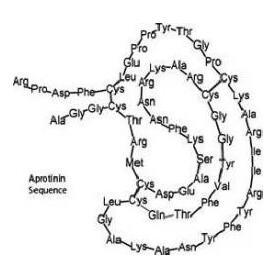Aprotinin
Référence M3651-5mg
Conditionnement : 5mg
Marque : AbMole Bioscience
All AbMole products are for research use only, cannot be used for human consumption.

Quality Control & Documentation
Biological Activity
Aprotinin is a competitive serine protease inhibitor. Aprotinin reversibly binds to and blocks the enzymatic active site. Aprotinin inhibits a range of serine proteases including trypsin, chymotrypsin, kallikrein and plasmin.
Activity: 5868KIU/mg (4.51TIU/mg)
Product Citations
-

Cells. 2021 Feb 18;10(2):430.
Knockdown of AKT3 Activates HER2 and DDR Kinases in Bone-Seeking Breast Cancer Cells, Promotes Metastasis In Vivo and Attenuates the TGFβ/CTGF Axis
Aprotinin purchased from AbMole
Protocol (for reference only)
| Cell Experiment | |
|---|---|
| Cell lines | mouse G8-1 and C2C12 skeletal muscle myoblasts |
| Preparation method | Olating mouse G8- 1 myoblasts DMEM + 20% FBS (maintenance medium), in which they remain undifferentiated. When cells reache approximately 40-50% confluence, adding different protease inhibitors to the culture media and incubating cells overnight. Then switching cells to differentiation-promoting media (DMEM + 10% horse serum ?protease inhibitor) and incubating for 7 days. |
| Concentrations | 2 TIU/ml |
| Incubation time | 12hrs |
| Animal Experiment | |
|---|---|
| Animal models | Male Wistar rats |
| Formulation | physiological saline |
| Dosages | 1.5 mg/kg and 3 mg/kg/h, 3 mg/kg and 6 mg/kg/h up to 5 mg/kg and 10 mg/kg/h ological saline |
| Administration | bolus injection followed by a maintenance infusion(i.p.) |
Chemical Information
| Molecular Weight | 6511.48 |
| Formula | C284H432N84O79S7 |
| CAS Number | 9087-70-1 |
| Solubility (25°C) | Water ≥ 50 mg/mL |
| Storage | Powder -20°C 3 years ; 4°C 2 years In solvent -80°C 6 months ; -20°C 1 month |
References
[1] Reichel CA, et al. PLoS One. Plasmin inhibitors prevent leukocyte accumulation and remodeling events in the postischemic microvasculature.



